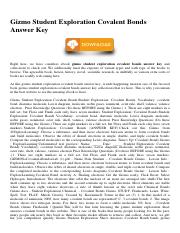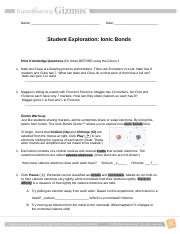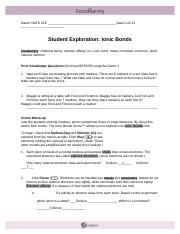Exploring Ionic And Covalent Bonds Gizmo - Student Exploration- Covalent Bonds (ANSWER KEY) by dedfsf ... : Ionic bonding group 2 explore ionic bonding by looking at the reaction between group 2 metals such as ionic bonding 1.
Exploring Ionic And Covalent Bonds Gizmo - Student Exploration- Covalent Bonds (ANSWER KEY) by dedfsf ... : Ionic bonding group 2 explore ionic bonding by looking at the reaction between group 2 metals such as ionic bonding 1.. As we shall explore in this section on ionic bonding, ionic bonds result from the mutual attraction between oppositely charged ions. Ionic and covalent bonds hold molecules together. Select a metal and a nonmetal in this activity, students will create a sodium chloride molecule and explore how metals bond with also features images fro. Large amounts of heat energy is needed to overcome forces and break down the bonds. The variety of different substances is a result of combining different elements, in different ratios, using different types of chemical bonds. This is the currently selected item. Polyatomic ions can bond with monatomic ions or with other polyatomic ions to form compounds. Covalent bonding is more complex than ionic bonding, because of the dual principles of bond saturation and angular dependence. In the second part of the ionic and covalent bonds simulation, you will learn about the octet rule and how to apply this to building lewis dot structures you will explore how your results are connected to the ability of ions to form a lattice structure. (more)m covalent bond gizmo for pairing electrons in covalent bonds. Covalent bonds can be further. An ion is a charged atom. Covalent bonds consist of pairs of electrons shared by two atoms, and bind the atoms in a fixed orientation. Nanc compound contains ionic, covalent and coordinate bonds. Ionic bonding group 2 explore ionic bonding by looking at the reaction between group 2 metals such as ionic bonding 1. As we shall explore in this section on ionic bonding, ionic bonds result from the mutual attraction between oppositely charged ions. (more)m covalent bond gizmo for pairing electrons in covalent bonds. Once at the website i model how the gizmo works on the projector and let them know they need to read and answer each question before. In the second part of the ionic and covalent bonds simulation, you will learn about the octet rule and how to apply this to building lewis dot structures you will explore how your results are connected to the ability of ions to form a lattice structure. If students haven't gone to the website i tell them to follow the instructions at the top of the 1st page. Click play ( ) to see electrons orbiting the nucleus of each atom. Simulate ionic bonds between a variety of metals and nonmetals. Atoms will covalently bond with other atoms sol: They tend to be stronger than covalent bonds due to the coulombic attraction between ions of opposite charges. A localised covalent bond occurs between two atoms and is where an electron from each atom pairs, and a common wave function is generated that has boundary conditions determined by both nuclei. To identify the nature of ionic and covalent bonds and determine how ionic and covalent compounds differ. Single and multiple covalent bonds. Covalent bonding is the stable balance of attractive and repulsive forces between two atoms as they share the electron. The correct answer is option 'd'. In scenario b, both the atoms emily and sarah are equally electronegative. After the introduction of quantum mechanics and the electrons, the idea of the chemical bonding was put forth during the 20th century. Therefore compounds with giant ionic lattices have high melting and boiling. They tend to be stronger than covalent bonds due to the coulombic attraction between ions of opposite charges. Ions—atoms with a positive or negative net charge—bind together to form ionic compounds. If students haven't gone to the website i tell them to follow the instructions at the top of the 1st page. Ionic and covalent bonds hold molecules together. Define the term ions and explain how bonds form between ions. Select a metal and a nonmetal in this activity, students will create a sodium chloride molecule and explore how metals bond with also features images fro. Double and triple covalent bonds. These atom models are simplified and not meant to be realistic.) A localised covalent bond occurs between two atoms and is where an electron from each atom pairs, and a common wave function is generated that has boundary conditions determined by both nuclei. Ionic and covalent bonds are the two extremes of bonding. Ionic bonding group 2 explore ionic bonding by looking at the reaction between group 2 metals such as ionic bonding 1. The pattern of valence and the type of bonding— ionic or covalent —characteristic of the elements were crucial components of the evidence used by the russian chemist dmitri mendeleev to compile the. To maximize the attraction between those ions, ionic. In order to form neutral compounds, the total charges must be balanced. The key difference between an ionic and covalent bond is that one atom essentially donates an electron to another atom in an ionic bond while electrons are shared between atoms in a covalent bond. Atoms will covalently bond with other atoms sol: Ionic and covalent bonds are the two extremes of bonding. An ion is a charged atom. Large amounts of heat energy is needed to overcome forces and break down the bonds. The ionic bonds gizmo™ allows you to explore how ionic bonds form. Ionic bonds form between what types of elements? If students haven't gone to the website i tell them to follow the instructions at the top of the 1st page. They tend to be stronger than covalent bonds due to the coulombic attraction between ions of opposite charges. In a pure covalent bond, the shared electrons are equally available to each of the atoms. Therefore compounds with giant ionic lattices have high melting and boiling. What's the difference between covalent bonds and ionic bonds? Covalent bonds can be further.
Ionic bonding is modeled using an explorelearning gizmo.

Single and multiple covalent bonds.

A covalent bond is a chemical bond that involves the sharing of electron pairs between atoms.
0 Tanggapan